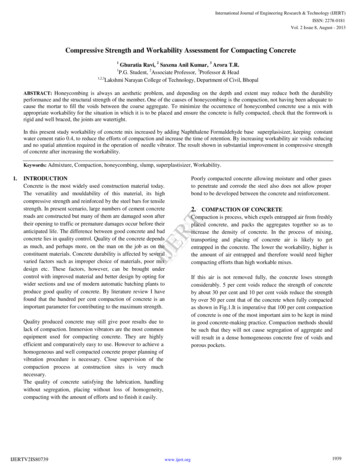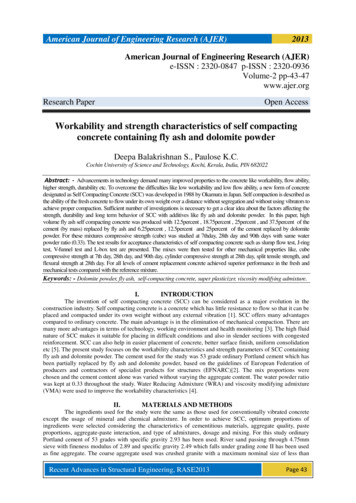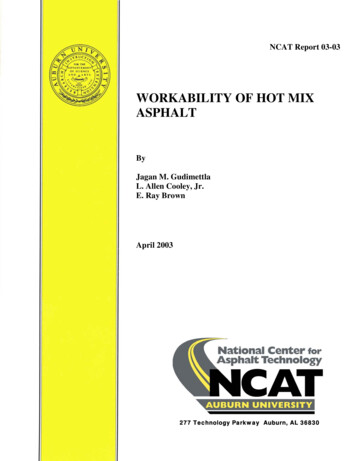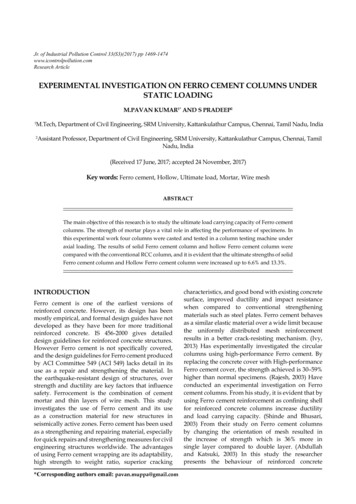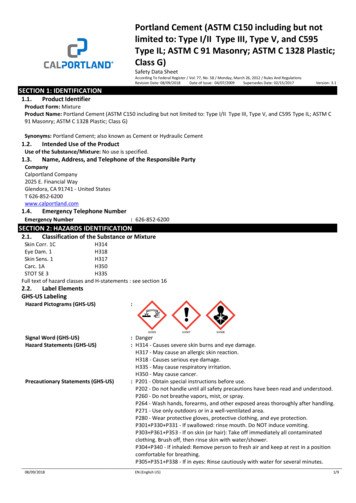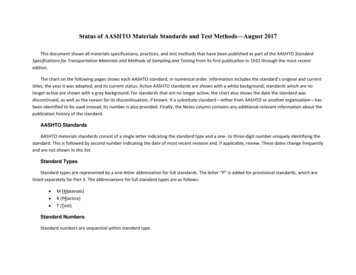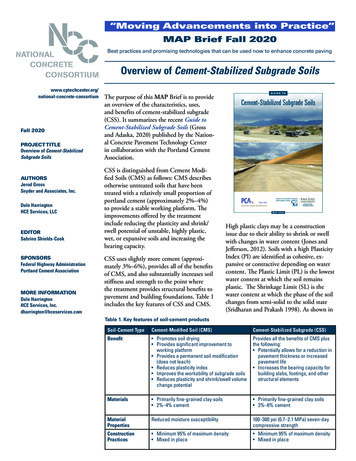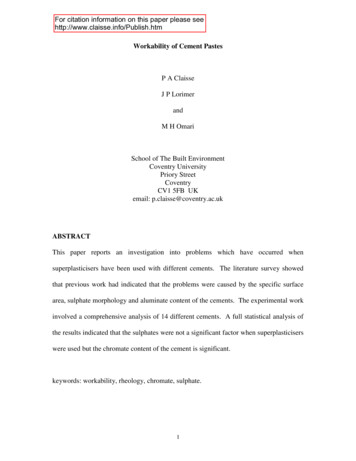
Transcription
For citation information on this paper please seehttp://www.claisse.info/Publish.htmWorkability of Cement PastesP A ClaisseJ P LorimerandM H OmariSchool of The Built EnvironmentCoventry UniversityPriory StreetCoventryCV1 5FB UKemail: p.claisse@coventry.ac.ukABSTRACTThis paper reports an investigation into problems which have occurred whensuperplasticisers have been used with different cements. The literature survey showedthat previous work had indicated that the problems were caused by the specific surfacearea, sulphate morphology and aluminate content of the cements. The experimental workinvolved a comprehensive analysis of 14 different cements. A full statistical analysis ofthe results indicated that the sulphates were not a significant factor when superplasticiserswere used but the chromate content of the cement is significant.keywords: workability, rheology, chromate, sulphate.1
INTRODUCTIONCement grouts are used for a wide range of applications in the constructionindustry. These grouts require a high workability and superplasticising admixtures areused to achieve this.It had been found that some cement pastes perform better (i.e. flow faster and areworkable for longer times without bleed and segregation) in some countries than in othersThese problems may be solved on an empirical basis when they arise. However thisproject investigated the basic mechanisms involved in order that the performance of thecement pastes might be predicted more effectively.To do this, a relationship between the rheological properties of the cement pasteand the chemical components, especially the different kinds of sulphates, of the Portlandcement was established. First, a relationship between the simple industrial tests such asthe flow cone and the rheological properties obtained by a rheometer was established.This has been reported elsewhere (1,2). Subsequently, more tests were performed such asX-ray Fluorescence (XRF) spectroscopy to determine the chemical composition ofcement, Thermo Gravimetric Analysis (TGA) to determine the different types ofsulphates, Particle Size Distribution (PSD) and Specific Surface Area (SSA) tests. Inorder to relate the chemical composition to the rheological properties 14 differentcements from various countries were analysed.The TGA system used was unable to differentiate between the amount of gypsumor hemihydrate present. In order to estimate the amounts of gypsum and hemihydrate itwas necessary to use X-Ray Diffraction (XRD) and then calculate the mass of water inthat amount (that represented the water content in hemihydrate). It was then subtracted2
from the results obtained from the TGA system to obtain the mass of water thatrepresented gypsum.LITERATURE SURVEYProperties affecting paste rheologyNumerous studies of the rheological properties of cement pastes have provedthese properties depend on many factors. The following have been frequently cited: thewater / cement ratio (w/c) [3,4], specific surface area, mineral composition [3,5,6],conditions during measurements and their duration [3,7] (i.e., time dependency, mixingtime and mixing intensity) and temperature [5,8]. Previous researchers found that thecement paste had better workability when using high w/c ratio, low SSA cement and highmixing speed. It has been shown that the most important of these are the w/c ratio andspecific surface area [3]. Studies performed on cement pastes of different chemicalcomposition indicated this factor has less effect on the rheology than the w/c ratio and/orthe fineness of the cement [9,10] (this is already optimised in commercial cements). Themost significant reported influence of chemical composition is in the retardation of thealuminate hydration by calcium sulphate [11]. Due to the considerable reaction rates ofthese processes they are very important when determining rheological features of cementpastes at early hydration stages and also affect the development of rheological properties[3].The effect of cement chemistry on paste rheology3
The most relevant study to this study was performed by Greszczyk and Kucharska[3]. Their experiments were carried out using 21 industrial clinkers and cements. Allcements contained an equal amount of gypsum (5% wt). Both clinkers and cements were20 m2/kg. The chemical composition of theground to the specific surface area of 300clinkers were recorded (%wt.) stating the four main phases (see 1.3.1) C 3S, C2S, C3A andC4AF and Na2O, K2O, SO3 and free CaO. The rheology measurements were obtainedusing a rotary viscometer Rheotest RV-2. Measurements were performed at a constanttemperature of 21 C and the w/c for clinker and cement pastes were 0.50 and 0.40respectively. The preparation of the pastes included manual mixing for 3 minutesimmediately after the clinker and/or cement contacted water. The paste was left to standfor 5 minutes before it was fed into the viscometer. Then 1 minute of mixing wasperformed at a shear rate 146 s-1 after which it was left for a further 1 minute at restbefore the start of measurements. Thus, measurements were started after 10 minutes ofthe contact of cement with water. The rheological behaviour of the tested clinker andcement pastes were determined based on the obtained flow curves and results on stresschange measurements taken within a one hour period at a constant shear rate (146 s-1).The plastic viscosity and shear stress values for cement and clinker were measured at 30and 60 minutes. Greszczyk and Kucharska found that the shear stress at 30 and 60minutes increased with the increase of C3A content. The increase in the alkali contentincreased the shear stress at 30 and 60 minutes. The efficiency of gypsum as a settingcontrol agent was reduced when using a highly reactive clinker (i.e. clinker with anorthorhombic morphology of tricalcium aluminate (C3A) and a high content of alkalies)due to the increased reactivity of C3A caused by alkalis (potassium).4
However in the author’s opinion, the sample preparation techniques were notadequate. For example a manual mixing procedure of 3 minutes produces an inadequatemixed cement paste. Banfill [12] and Hakansson, Hassler and Stille [8] showed that amixing time of about five minutes is the required minimum to obtain constant propertiesfor both the yield stress and the plastic viscosity [8]. Inadequate mixing will result in nonreproducible properties [8]; this effect was tested in this project. Low shear mixing(manual mixing in case of Greszczyk and Kucharska) and a mixing time below 4 minutesis inadequate. Greszczyk and Kucharska's study was limited since the gypsum contentand the specific surface area were controlled to a very limited range of values. Testing therheological properties of a clinker with no added sulphates is unrealistic due to the falseset of the clinker paste. The study should have used commercial clinker with controlledaddition of sulphates.The effect of sulphate compounds on paste rheologyThe second important study in this area was performed by Mork and Gjoerv [13].During the grinding of cement clinker and gypsum in cement production, relatively hightemperatures occur which may reduce the gypsum to hemihydrate or soluble anhydrite.The amount of this reduction may also depend on the quality of the gypsum and theconditions used later during storage and transportation of the cement. Since the solubilityof hemihydrate and soluble anhydrite is approximately three times higher than gypsum,an uncontrolled variation in the gypsum-hemihydrate ratio may cause an uncontrolledvariation in the chemical reactivity of the system and hence on the workability propertiesof the fresh cement pastes. An uncontrolled variation in the gypsum-hemihydrate ratio5
may also cause an incompatibility between the cement and certain types of admixturessuch as superplasticisers. Such incompatibility may cause false set or quick set of thefresh cement pastes [13,14]. Mork and Gjoerv used three different gypsum-hemihydrateratios, namely 80/20, 50/50 and 20/80. Their testing program was further based on twodifferent types of clinker, one more reactive (i.e. with an orthorhombic morphology ofC3A and a high content of alkalies) than the other. The “reactive” clinker was ground totwo different levels of fineness, namely 300 and 400 m2/kg and 3% of sulphates wereadded with different gypsum-hemihydrate ratios. The less reactive clinker was ground toa fineness of 300 m2/kg and 1,2 and 3% of sulphates were added with different gypsumhemihydrate ratios. The mixtures which contained sulphonated melamine formaldehydewere mixed using a water-cement ratio of 0.45. The mixtures which did not containsuperplasticiser were mixed using a water-cement ratio of 0.61. The mixtures were testedAfter 1, 20, 30, 50 and 70 minutes of mixing using a coaxial viscometer of type BMLViscometer. Mork and Gjoerv [13] concluded the following:1. For the most reactive type of clinker with a high content of both C3A and alkalis, areduced gypsum-hemihydrate ratio from 80/20 to 20/80 reduced the yield stress,while plastic viscosity was not much affected. The initial yield stress and theincreased yield stress over time were reduced by the reduction of gypsumhemihydrate ratio.2. For the less reactive type of clinker, the effect of the gypsum-hemihydrate ratio wasnot so pronounced. A tendency to false set was observed only for the lowest ratio of20/80. For this type of clinker, the change over time in rheological properties was also6
smaller. However, a reduced total sulphate content from 3% to 1% reduced both yieldstress and plastic viscosity.3. In the presence of a melamine-based superplasticiser, a more pronounced effect of thegypsum-hemihydrate ratio on the rheological properties of fresh cement pastes wasobserved. However, for the most reactive type of clinker, a reduced gypsumhemihydrate ratio increased the yield stress, while for the less reactive type of clinkerthe effect was still less pronounced. An increased fineness of the cement increased theeffect of gypsum-hemihydrate ratio, while a reduced total sulphate content reducedthe observed yield stress.It’s the author’s belief that most commercial cements have a much lower contentof hemihydrate than those explained in Mork and Gjoerv’s study. A cement manufacturerattempts, where possible, to produce 0% of hemihydrate in the final product since it“kills” the workability of cement pastes. Some companies add Anhydrite instead ofgypsum to ensure that the hemihydrate content is zero. Temperature controlled grindingmay be used to convert the hemihydrate where the cost of Anhydrite is too high. Theauthor believes that Mork and Gjoerv’s study would have been more useful if thegypsum-anhydrite and the anhydrite-hemihydrate ratios had also been investigated.However the study of Mork and Gjoerv gave the author the idea for the tests which aredescribed in this paper. These tests include 12 different mixes with different ratiosbetween gypsum, hemihydrate, and anhydrite.An initial trial from this programme has been reported (1,2). In this experimentcement clinker without added sulphate was ground and mixed with pure gypsum and pure7
anhydrite.The results are shown in table 1, and indicate a substantially higherworkability with Gypsum.TABLE 1 Effect of Sulphates [1,2]PlasticiserSMFSMFSNFSNFPropertyViscosityPa s 10-7YieldPa 10-7ViscosityPa s 10-7YieldPa 1EXPERIMENTAL METHODSMaterialsCements were obtained from different commercial suppliers.Three differentsuperplasticising admixtures were used:Sulphonated Melamine Formaldehyde (SMF)Sulphonated Napthalene Formaldehyde (SNF)Lignosulphonate (LS)Rheological TestsThe Rheometer: This test measures the viscosity and the shear stress of a cement paste. ARheology International Series 2 viscometer Model RI:2:M was used. The viscometer was8
chosen with a medium spring to be able to obtain more accurate data at low speeds. TheBingham model was used to determine the plastic viscosity and the yield value.It should be noted that the rheology of Bingham plastics is not very sensitive totemperature, but the rate of change of rheology with time in a chemically reacting systemcontaining cement is affected by temperature. It is preferable to standardise both the testtemperature and the time after mixing at which the test is performed [Banfill 1994]. Allthe tests reported here were performed at 201º C. The test materials were stored at thistemperature for at least 48 hours before use.A four-bladed vane spindle (Figure 1) was used for this work. The vane had fourrectangular blades of radius, Rv, 9.5 mm and height, h, 38 mm and was placed in a cup ofradius 27.5 mm centrally mounted on the lower plate. Because of the restricted torsion ofthe spring which moves the spindle, these actual dimensions do not comply with thoserecommended the ASTM [ASTM D2573] (Rv 19.05 mm and h 76.2 mm). However, theactual rheometer used was capable of producing comparative data on which decisionsregarding mix could be made.The shear stress, , was calculated from the torque (T) using the followingconversion formulae: 3T/(2 (Rv3 3 Rv3h))[15]The Testing CycleThe testing cycle (Fig. 2) was chosen in order to keep within the restrictions of theapparatus and reduce the anti-thixotropic behaviour that the material might have. It wasnoticed that reducing the readings on the down-curve from 20 data points to 10 did not9
affect the accuracy in obtaining the yield value and the viscosity. However, reducing thenumber of points on the down curve helped obtain a positive value of the slope(viscosity). This was because shortening the cycle reduced the effect of shear-thickening(anti-thixotropy) which some cement pastes have. The up-curve utilised 20 data points toensure that the break point could be determined more accuratelyThe testing cycle was checked by performing a series of "single point" tests atfixed speeds and comparing the results with a test using the normal testing cycle. Theresults were very similar which indicated that they were not a product of the particulartesting cycle that was used.Figure 2 also shows how the viscosity, yield point and break point are derivedfrom the results of the cycle. Relating these to practical applications, the break pointindicates how easily a mix may be moved from a static position (e.g. resting in a pipe).The yield shows the resistance to flow (e.g. pumping pressure) at slow speeds and theviscosity shows how the resistance to flow increases as the speed (e.g. the rate ofpumping) increases.The effect of mixing speed and time on the rheological propertiesIt was noticed that the speed of mixing affected the initial flow of the cementpaste when mixed for 5 minutes. A standard mixing speed and mixing time had to bechosen for the final testing. A series of tests on trial samples were carried out. Differentmixing speeds (900, 1100, 1300, 1500 and 1900 rpm) and mixing times (2, 3, 4 and 5minutes) were tested. The samples were tested 3 minutes after finishing mixing10
It was found that (Figure 3) mixing for longer times (4 & 5 minutes) gave a betterworkability and stability for the cement pastes. Mixing for 2 or 3 minutes was inadequate,and that caused the unexpected increase of break point value with the increase of speed.Mixing at very high speeds ( 1100 rpm) gave a high workability and made the cementpaste too thin for the rheometer (anti-thixotropic behaviour). Therefore the followingmixing method was used:After pouring all the material into the mixing beaker, while the mixer’s spindlewas rotating at 1100 rpm, the timing was started. After 40 seconds the speed was raisedto 1900 rpm for 20 seconds to ensure that all the lumps were broken. The speed wasreduced to 1100 rpm for 2 minutes and 40 seconds (i.e. 160 seconds) and again raised to1900 rpm for 20 seconds. Finally the speed was lowered to 1100 rpm for 1 final minuteof mixing. This made the total mixing time equal to 5 minutes. When not using any waterreducer or when using lignosulphonate plasticiser, the mixing speed was kept at 1900rpm for the complete 5 minutes to ensure that the material would be workable enough forthe rheometer. This mixing method was used to ensure that no lumps would form and thecement paste would be properly mixed.Relating this mixing to the methods used in practice is difficult because noshearing was used. In a commercial grout mixer the pumping action will shear the mixand this will provide effective mixing at relatively low speeds. In concrete the aggregatewill shear the paste during mixing.The standing time of the cement paste11
The standing time of the cement paste before testing affected its rheologicalproperties. Three samples were tested at different standing times; 0.5, 1, 2, 3 and 4minutes. Increasing the standing time increased the yield value (Figures 4a and 4b). Astanding time of 1 minute was chosen to give enough time to load the sample into therheometer and start testing.Mix DesignsAfter studying all the initial tests the final mix designs were chosen as follows:Blank sample without any plasticiserCement100%W/c0.50SNF/SMF sampleCement99.70%SNF/SMF0.30%W/c0.40LS sampleCement99.70%LS0.30%W/c0.45The amount of powder used in the samples was 300 g.Measurement of Particle Size and Specific Surface Area12
Testing of particle size was performed using the Malvern 2600 particle sizer withdry-powder feeder. This semi-computerised particle sizer has three lenses to cover arange from 0.5 m to 568 m. The analyses were in the range of 1.22 - 188 m. TheSSA was automatically calculated by the computer.The tests were performed intriplicate, each time with approximately 150 g. If any drift in the results was observed,the analysis was repeated. Six sieve sizes were used: 90.9 m, 73.1 m, 50.8 m, 30.6m, 10.3 m, 3.46 m and 3.46 m.ThermoGravimetric MeasurementsA Setaram TG system was used and it was able to detect the free water ( 105º C)and combined water ( 105º C) present. The heating rate was 2º C/minute and the samplesize was 150mg.X-Ray FluorescenceCement samples were analysed for the following oxides: SiO2, Al2O3, Fe2O3, CaO, MgO,K2O, Na2O, Mn3O4, P2O5, SO3, TiO2, ZrO2, Cr2O3, BaO and SrO. The analysis wascarried out using a Philips PW2400 XRF spectrometerX-Ray DiffractionXRD was used to determine the quantity of hemihydrate (CaSO4.½H2O) in thecement. In order to measure this, preliminary scans were performed on:Anhydrite (CaSO4) to check that the peaks of calcium sulphates and help inpredicting the region where the distinctive peaks of hemihydrate might appear,13
hemihydrate to determine the distinctive peaks of hemihydrate,clinker with added gypsum to check that the peaks of gypsum do not overlap with thedistinctive peaks of hemihydrate.clinker (with no added sulphates) to be able to compare it with the analysis graphs ofthe tested samples.After considering the XRD spectrum, it was decided to discard the first peak ofhemihydrate since it overlapped with the gypsum peaks. Calculating the amount ofhemihydrate was easy, the distinctive peak of hemihydrate height represented 100% ofhemihydrate content, while the same “region” in clinker represented 0% of hemihydrate.The XRD analyses of 14 cements were compared with the clinker analysis to detect thehemihydrate peak and calculate its content.RESULTSThe results are shown in Tables 2 to 4. These results will not have been asaccurate as the resolution shown in the table but, in line with statistical practice, theywere not rounded before use in the calculations. The chemical and physical properties ofthe cements were correlated to the rheological properties of cement pastes usingstatistical computer programs. It was observed that the flow of cement paste is dependentmainly on SSA and Particle Size Distribution which is correlated to SSA. The effect ofSSA was removed to reveal other factors which could affect the flow. The other mainfactors were removed in turn. The most important factor to consider when building amodel is the level of significance (P-value) of each estimated coefficient. The lower the14
P-value, the more significant the contribution of that variable to the model. A 0.05 Pvalue indicates a 5% probability that the relationship between two variables could havehappened by chance. The highest acceptable level of significance in the present analysiswas 0.05.It was noted that multiple regression can sometimes suggest spurious relationshipsbetween variables, particularly where the independent variables are themselves highlycorrelated. Care was taken to ensure that relationships can be supported by experimentalevidence. Precautions were also taken against the danger of building a theory on one ortwo pieces of influential data which could be “rogue” values or “outliers”.The final flow models for the Break Point were (Figure 6):Break Point (Blank) [Pa] –1171[Pa] 1178 Hemihydrate%[Pa] 6 SSA [Pa kg/m2]Break Point (SMF) [Pa] – 7205[Pa] – 22380 Cr2O3%[Pa] – 10890 Na2O%[Pa] 1242 Al2O3%[Pa] 17 SSA [Pa kg/m2]Break Point (SNF) [Pa] – 20344[Pa] 2343 Al2O3%[Pa] 31 SSA [Pa kg/m2]Break Point (LS) [Pa] – 6244[Pa] –24468 Cr2O3%[Pa] 1128 Al2O3%[Pa] 7 SSA[Pa kg/m2]The final flow models for the Yield value were (Figure 7):Yield (Blank) [Pa] –1259[Pa] 1352 Hemihydrate%[Pa] 6 SSA[Pa kg/m2]Yield (SMF) [Pa] – 8999[Pa] – 26012 Cr2O3%[Pa] 1228 Al2O3%[Pa] 17 SSA[Pa kg/m2]Yield (SNF) [Pa] – 17278[Pa] 1965 Al2O3%[Pa] 28 SSA[Pa kg/m2]Yield (LS) [Pa] – 10504[Pa] 1138 Al2O3%[Pa] 19 SSA [Pa kg/m2]15
The final flow model for the Plastic Viscosity was (Figure 8):Plastic Viscosity (blank) [Pa s] 77[Pa s] 50 Hemihydrate% [Pa s] – 14 Al2O3%[Pas]No models for plastic viscosity for the superplasticised samples could be developed.DISCUSSIONThe main observations from these results are:The present results do not indicate that there is no effect of any given factor- theyonly indicate that it is not an effect which is statistically significant at the 5% levelIt is not indicated that the effect of sulphate morphology (i.e the relative amounts ofgypsum, hemihydrate and anhydrite) is very significant. The hemihydrate is onlysignificant where no admixtures are used. This partially contradicts the findingswhich were indicated in the literature and the preliminary work however these resultsrefer to total amounts present rather than the amounts in solution. Another factor(e.g. the chromate discussed below) could be controlling solubility and thus be moresignificant.The significance of the Aluminate phases. This was expected from the literature.An unexpected effect of the Chromate phases was observed. A brief additionalexperimental programme was carried out to investigate this observation.Blue Circle Wardale (BCW) cement was chosen to study the effect of variouslevels of Cr2O3 (0, 0.05, 0.07, 0.10, 0.15 and 0.20%) on the flow. This particular cementwas chosen since it contains no Cr2O3. All mixes were performed using the standardmixing method used for Blank mix. Figure 5 illustrates the effect of Cr2O3. These16
experimental results suggest that the significant relationship between Break Point andCr2O3 found by statistical analysis is genuine. Chromates are known to be retarders andin some cements special measures are taken to reduce the adverse effects of CrVI byreducing it to CrIII. Further investigation would be required to determine how this wouldaffect the models for their workability when superplasticised. In particular the effect ofchromates on sulphate solubility may be significant.CONCLUSIONSFor all cementitious mixtures the Specific Surface Area of the cement has the greatestinfluence on workability.For cementitious paste mixtures without admixtures the hemihydrate content has asignificant effect on workability.For cementitious mixtures with SMF, SNF or LS admixtures the workabilitygenerally increases with decreasing aluminate content.For mixes with SMF and LS admixtures the workability generally increases withincreasing chromate content.ACKNOWLEDGEMENTThe authors would like to acknowledge the support of Fosroc International in this work.REFERENCES1. Claisse P A and Al Omari M 1999, The Effect of Changes in Cement on the Propertiesof Cement Grouts with Superplasticising Admixtures, Proc. "The Role of Admixtures in17
High Performance Concrete", RILEM International Symposium, Monterrey, Mexico,March 21-262. Omari M A, 1999, Workability of Cement Pastes, PhD Thesis, Coventry University.3. Greszczyk S. and Kucharska L., 1991, “The Influence of Chemical Composition ofCement on the Rheological Properties”, Rheology of Fresh Cement and Concrete, Edit byBanfill PFG, pp 27-36.4. Collepardi M., 1971, “The Rheological Behaviour of Cement Pastes”, Il Cemento, Vol68, pp 99-106.5. Von Berg W, 1979, “Influence of Specific Surface and Concentration of Solid uponthe Flow Behaviour of cement pastes”, Magazine of Concrete Research, Vol 31, pp211216.6. Oaler I., Becker I. and Weiss B., 1978, “Rheological Properties of Cement Pastes”, IlCemento, Vol 3, pp 303-310.7. Banfill P.F.G., 1981, “On the Viscometric Examination of Cement Pastes”, Cementand Concrete Research, Vol11, pp 363-370.8. Hakansson U., Hassler L. and Stille H., 1997, “Rheological Properties of MicrofineCement Grouts”, Tunnelling and Underground Space Technology, Vol 7, No 4, pp 453458.9. Older I., Duckstein U. and Becker T., 1978, Cement and Concrete Research, Vol 8, pp469.10. Banfill P.F.G., 1981 b, “A viscometric examination of cement pastes containingsuperplasticisers with a note on experimental techniques”, Magazine of ConcreteResearch, pp 33, 37-47.18
11. Bombled J.P., 1980, “Influence of sulphates on the rheological behaviour of cementpastes and their evolution”, Proceedings of the 7th Int. Congress on the Chemistry ofCement, Vol 3, pp 164-169.12. Banfill P.F.G., 1983, “A Viscometric Study of Cement Pastes ContainingSuperplastesizers with a Note on Experimental Techniques”, Magazine of ConcreteResearch, Vol 33, pp 37-47.13. Mork J.H. and Gjoerv O.E., March-April 1997, “Effect of Gypsum-HemihydrateRatio in Cement on Rheological Properties of Fresh Concrete”, ACI Materials Journal, pp142-146.14. Dodson V.H. and Hyden T.D., 1990, “Another Look at the PortlandCement/Chemical Admixture Incompatibility Problem: How Effectively Use the NewestAdmixtures”, SCM 23-90, American Concrete Institute, Detroit.15. Banfill P.F.G. and Kitching D.R., 1990, “Use of a Controlled Stress Rheometer toStudy the Yield Stress of Oilwell Cement Slurries”, pp 125-135.19
Table 2. Chemical Properties of the CementsCementJordanGulfDubai NationalSharjah%SiO2 %TiO2 %Al2O3 %Fe2O3t %Mn3O4 %MgO %CaO %Na2O %K2O %P2O5 %SO3 %Cr2O3 %SrO21.02 1.29 0.72 0.73 lue Circle AberthawCastle PadeswoodRugby SouthamCastle RibblesdaleBlue Circle MasonsCastle Ribblesdale-RACanadaCastle 010.010.070.080.090.100.170.100.080.05Blue Circle CauldonBlue Circle 0.010.000.050.1720
Table 2 continuedCementJordanGulfDubai NationalSharjah%ZrO2 %BaO LOI Total% C4AF C3A C2S C3S %Anhydrite %Gypsum Hemihydrate0.010.01 1.23 99.857.90 9.65 16.61 57.891.350.750.300.000.01 1.08 99.9610.73 6.60 10.50 67.030.900.600.300.010.01 1.32 99.9610.28 7.70 8.16 67.961.100.780.320.010.02 1.57 100.22 11.86 7.00 10.18 65.320.401.110.19Blue Circle AberthawCastle PadeswoodRugby SouthamCastle RibblesdaleBlue Circle MasonsCastle Ribblesdale-RACanadaCastle 0.020.020.020.030.022.57 99.901.15 100.031.20 100.050.68 100.382.66 99.900.79 99.812.24 99.831.07 99.95Blue Circle CauldonBlue Circle Weardale0.010.010.020.021.09 99.802.02 100.096.54 7.52 2.35 75.015.26 10.38 5.95 72.536.78 8.08 3.68 75.418.57 8.33 10.20 66.2410.24 6.68 5.88 69.969.64 6.51 7.11 69.778.51 5.63 9.87 67.258.48 6.79 13.11 65.428.549.459.038.37The cements were separated into three groups according to their SSA.The Bouge equations were used to calculate the amount of phases.215.64 69.393.94 51.701.200.500.700.200.30
Table 3. Physical Properties of the CementsCementJordanGulfDubai PSDPSD90.9 m 73.1 m 50.8 Blue Circle AberthawCastle PadeswoodRugby SouthamCastle RibblesdaleBlue Circle MasonsCastle Ribblesdale-RACanadaCastle 11.3011.10Blue Circle CauldonBlue Circle 7.2034.9032.0025.3027.0012.4014.10Table 4. Results from the Rheological Tests22PSD30.6 m21.3015.2017.4018.60PSD10.3 m29.9038.7033.4036.60PSD3.46 m20.2024.8021.7023.20PSD 3.46 m7.907.808.609.00
JordanGulfDubai reak Viscosity YieldBreak Viscosity YieldPointPoint1574.30 811.8013.26721.66 1923.60 39.46 1352
cement paste had better workability when using high w/c ratio, low SSA cement and high mixing speed. It has been shown that the most important of these are the w/c ratio and specific surface area [3]. Studies performed on cement pastes of different chemical composition indicated this factor has less effect on the rheology than the w/c ratio and .
